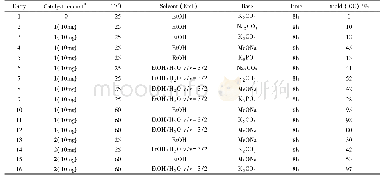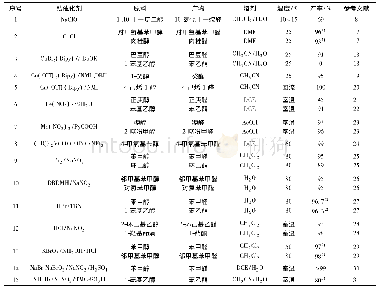《Table 1 Hydrogenation of nitrobenzene derivatives catalyzed by Au25@Ni-SiO2 (150) and Au25@Ni-SiO2
 提示:宽带有限、当前游客访问压缩模式
提示:宽带有限、当前游客访问压缩模式
本系列图表出处文件名:随高清版一同展现
《选择性控制的配体工程在金团簇催化中的作用(英文)》
a.Reaction condition:2 mmol substrate,4 mmol Na BH4,30 mg immobilized catalyst(Au 6.1*10-3mmol),and 2 m L ethanol/2 m L H2O
The as-prepared catalysts were tested for functional group tolerance(Table 1).Only the two opposite catalysts,Au25@Ni-SiO2(150)and Au25@Ni-SiO2(300),were compared,as they gave the sharpest contrast.It was observed that derivatives with electronwithdrawing groups(entries 1,4)were more active than those with electron-donating groups(entries 2 and3),since the room temperature was enough to convert the substrates over the catalysts.The results were consistent with previous patterns though some byproducts were generated.The Au25@Ni-SiO2(150)composite with S component gave rise to AXY derivatives as dominant products,while the other competitor yielded overwhelmed anilines.The steric effect from substrates was considerable as well.The groups on the para-positions didn’t interfere the contact between substrates and catalysts,and gave excellent conversion(entries2).On the contrary,the groups on the ortho-position hindered the access to metal(entries 3 and 4),along with the exterior ligands of Au25@Ni-SiO2(150)blocking the substrate approaching the active sites,hence low conversion at ambient conditions.As a result,the conversion was too low to make big differences on the product preference.These systematic results comprehensively verified the ligand effect on the catalytic properties,including activity and selectivity as scheme1 illustrated.
| 图表编号 | XD0018901700 严禁用于非法目的 |
|---|---|
| 绘制时间 | 2018.12.01 |
| 作者 | 高贵琪、崇汉宝、李广 |
| 绘制单位 | 安徽大学物质科学与信息技术研究院、安徽大学物理工程学院、安徽大学物质科学与信息技术研究院、安徽大学物理工程学院 |
| 更多格式 | 高清、无水印(增值服务) |





